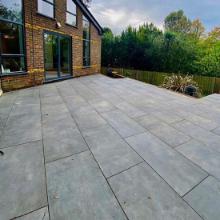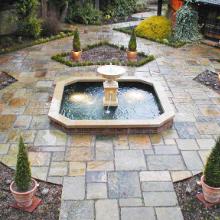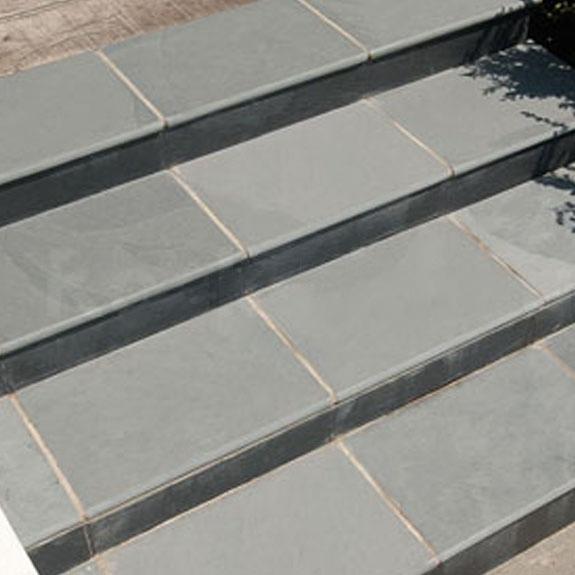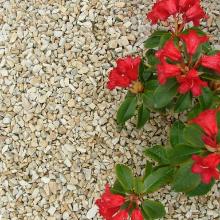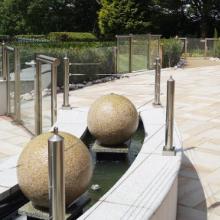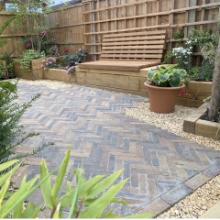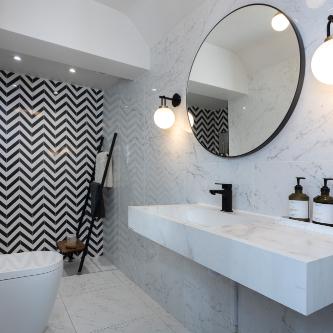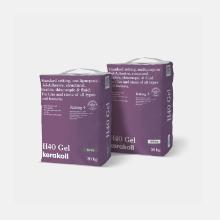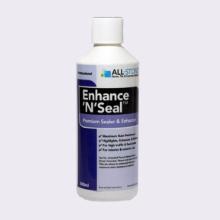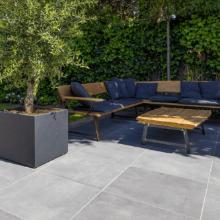An educational series explaining the science, technology, and craftsmanship behind modern
porcelain paving — from manufacturing to performance in outdoor environments.
Porcelain vs. Natural Stone Paving – Which Should You Choose?
Choosing between porcelain and natural stone paving comes down to understanding their nature.
Porcelain is a man-made material created from refined clays and minerals fired at very high
temperatures. It’s non-porous, consistent in colour, and resistant to frost, staining, and algae.
Natural stone, by contrast, is quarried directly from the earth and cut into slabs, each piece carrying its own pattern and tone. Stone paving — such as sandstone, limestone, or granite — brings individuality and character. It weathers naturally and often develops richer tones over time.
Porcelain offers precision and predictability: perfect sizing, even thickness, and low maintenance.
For contemporary spaces where clean lines, uniform colours, and long-term performance matter, porcelain is often the best choice. For rustic or traditional gardens that celebrate natural variation, stone remains timeless.
In short:
- Porcelain: modern, uniform, low-maintenance.
- Stone: natural, varied, classic.
Understanding Slip Ratings (R11, R12): What They Really Mean Outdoors
Safety underfoot is essential in outdoor paving. European standards use the “R” rating (short for “Ramp test”) to measure slip resistance.
- R9 is smooth – suitable for interiors.
- R10 has mild grip –for kitchens or light-traffic zones.
- R11–R12 are anti-slip surfaces ideal for patios, paths, and driveways.
- R13 is extremely rough – usually for industrial areas.
Most outdoor porcelain tiles from leading European manufacturers are rated R11 or R12, ensuring secure footing even when wet.
Texture is added either during pressing or by applying a micro-structured glaze before firing. It’s important to remember that slip resistance can vary between finishes, even within the same collection.
Always check the R-value before purchase, particularly for steps, pool surrounds, or
slopes.
How Frost Resistance Works in Porcelain and Stone Paving
Frost resistance depends on how much water a material absorbs. When absorbed moisture
freezes, it expands, potentially cracking the surface. Porcelain has less than 0.5% water absorption because its structure is fully vitrified — the pores are sealed during high-temperature firing. This makes it virtually frost-proof, even in harsh British winters. Dense stones like granite or basalt resist frost well, or softer limestones and sandstones can absorb more water and therefore need to be selected more carefully for suitability of use.
Correct installation also matters: good drainage beneath the surface prevents standing water from freezing and damaging joints. In short, porcelain’s vitrified structure means it can tolerate sub-zero temperatures year after year without deterioration — making it a superb long-term choice for UK outdoor spaces.
Why Porcelain Thickness Matters: 9 mm, 16 mm, and 20 mm Explained
Porcelain paving is produced in several thicknesses, each designed for specific applications: - 9 mm – ideal for indoor floors or wall cladding.
- 16 mm – used where a lighter weight or retro-fit is required.
- 20 mm – the standard for outdoor paving, engineered for strength and frost resistance.
Thicker tiles can handle greater loads and wider joint gaps. A 20 mm porcelain slab has a breaking strength exceeding 13 kN — suitable even for driveways when properly installed on a stable base.
Matching indoor and outdoor thicknesses allows a seamless transition between spaces. Many Italian manufacturers produce identical finishes in both 9 mm and 20 mm variants, enabling continuity of design from kitchen to terrace.
How Modern Inkjet Printing Recreates Real Stone Textures
The surface beauty of today’s porcelain tiles comes from advanced digital inkjet printing.
High-resolution scanners capture microscopic details from real stone, wood, or concrete. These digital images are then printed onto unfired porcelain using up to 12 colour channels, producing natural tonal variation and surface relief.
Manufacturers can even apply different glaze textures to mimic riven stone, brushed limestone, or split slate. The result is near-perfect realism with none of the natural flaws or porosity.
Leading Italian and Spanish factories upgrade their printing systems regularly — often every year — to stay at the cutting edge of detail and colour accuracy.
The Life Cycle of a Porcelain Tile – From Quarry to Garden
Porcelain may be man-made, but its journey starts in the earth. Raw materials — kaolin, feldspar, and quartz — are extracted from quarries, refined, and mixed. The blend is ground, spray-dried, pressed, printed, and fired at over 1,200°C. Each stage, from robotic handling to laser inspection, ensures precision and sustainability. Waste is recycled, and water is reused in closed systems.
The fired tiles are sorted, batch-labelled, and shipped to distributors such as Rock Unique. Once installed, porcelain requires little maintenance, consumes no ongoing chemicals, and lasts decades without fading. Its long service life and recyclability make it a genuinely sustainable surface choice.
Understanding Vitrification and Why It Makes Porcelain So Durable
“Vitrification” is the process that turns porcelain from clay into an exceptionally hard, glass-like material. During firing, feldspar melts and fills the microscopic gaps between quartz and clay particles, creating a solid, non-porous structure. This vitrified matrix is what gives porcelain its strength, stain resistance, and low water absorption. It’s also what makes porcelain so dense that it cannot be cut with standard masonry tools — diamond blades are required.
Vitrification not only enhances durability but also ensures colour stability and frost protection.
Unlike concrete or softer stones, porcelain does not fade, erode, or absorb moisture.
